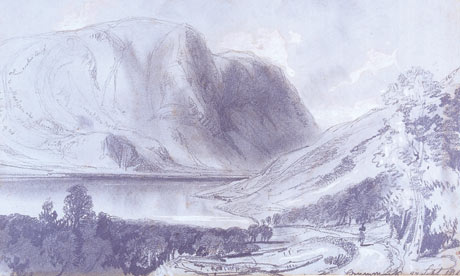
It was August 1836, and raining in the Lake District. As far as the artist and poet Edward Lear was concerned, it was always raining in the Lake District.
An exhibition that opens next month – at Wordsworth's Dove Cottage – of unpublished letters written in Lear's three months tramping around the region, and watercolours exhibited for the first time, may do wonders for his reputation but not for the Lake District tourist board. The hilarious accounts in the letters, and the ominously swollen grey clouds in the watercolours, are all full of rain. "Day after day incessant torrents flood the land," he wrote in September.
Lear wanted recognition as a serious artist, but became famous eventually as one of the best loved nonsense poets in English, and his letters are full of soggy jokes. "I went to the Wet City of Kendal, where it always rains – & the dear little babies are born with fins – webbed feet – & umbrellas under their arms" he wrote to one friend, and to another: "Hoping to get some sketching at the noble ruins of Furness Abbey – Lord bless you! it poured deluges from five in the morning until eight at night."
The paintings and letters give fascinating glimpses of the Lake District when the tourist industry was in its infancy. The curator, Charles Nugent, has hunted them out from many private collections, but a dozen drawings are missing that may show Wordsworth's home in Grasmere, or even an encounter with the poet himself.
All his life Lear felt himself to be a social misfit: brought up by an older sister after his father went bankrupt; poorly educated and largely self-taught as an artist; suffering from asthma and poor eyesight; battling demons of depression and epilepsy. He began by illustrating birds for ornithology books, but the fine detail almost wrecked his eyes: he wrote to one friend that he would soon be unable to draw anything smaller than an ostrich.
"It wasn't so much that he wanted to take up landscape art," Nugent said, "it was absolutely forced on him if he was to keep working at all."
His great patron Lord Derby – The Owl and the Pussycat was originally written to entertain his children – suggested he would profit from the Lake District. And so in August 1836 off he went, sometimes walking for 12 hours from five in the morning, with wildly varied accommodation from aristocratic houses where Derby gave him introductions, to remote country inns. In some of the grander houses he started in the servant's hall but, like Jane Eyre, was brought up to the drawing room to entertain the company, something which caused him agonies of shyness – and probably didn't endearing him to the servants, either.
Lear caricatured himself mercilessly: "His mind is concrete and fastidious/ His nose is remarkably big;/ His visage is more or less hideous/ His beard it resembles a wig." Nonetheless, Nugent says: "The ladies were always all over him, he completely charmed them. He is a most endearing character, he appeals to something in all of us."
Lear didn't know it, but his life was about to change forever, and he would never again have to face Kendal in the rain. The following year Derby gave him enough money, on the kindly pretext of buying drawings in advance, to spend years in Italy.
"The Lake District wasn't the beginning of something, it was a dead end," Nugent says, "which is why these drawings were never worked up into paintings, and why people have overlooked them until now."
• Edward Lear the Landscape Artist, The Wordsworth Trust, Grasmere, Cumbria, LA22 9SH

